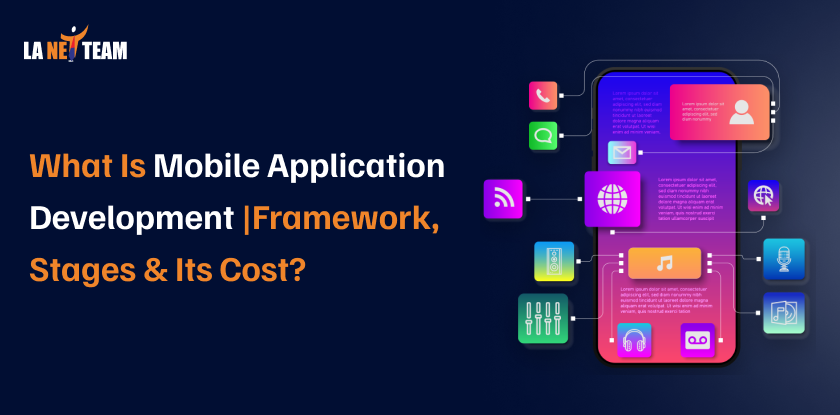We all use apps daily. Whether it’s checking ‘WhatsApp’ messages, booking a ride, or ordering food from ‘DoorDash’.
They have become a big part of our daily lives. In fact, over 85% of internet users spend their time on mobile apps and not on websites.
But have you ever thought…. How are these apps built to work smoothly on our phones?
MOBILE APPLICATION DEVELOPMENT… is the process that creates apps that can be run smoothly on mobile devices.
In fact, big brands like Amazon, Uber, and Starbucks all make well-designed mobile apps to connect with millions of users daily.
Mobile Application Development: Definition
Mobile development is a process of building software and made to run on mobile devices such as smartphones, tablets, or even smartwatches.
The aim is to create apps that appear good, work smoothly on smaller screens.
The process of mobile application development includes 2 key parts:
- Designing the apps: It’s about how it will look, feel, and interact with users.
- Coding the apps: It’s about writing the code that makes the app function for mobile.
Although it is similar to building websites or desktop applications.
But building a mobile app is unique, because they can directly use the features such as GPS, Bluetooth, the camera and microphone built into their device.
Today, most mobile apps are made for iOS (Apple devices) and Android (Google devices). Since these 2 platforms are dominating the global market.
How Much Does It Cost to Develop A Mobile App?
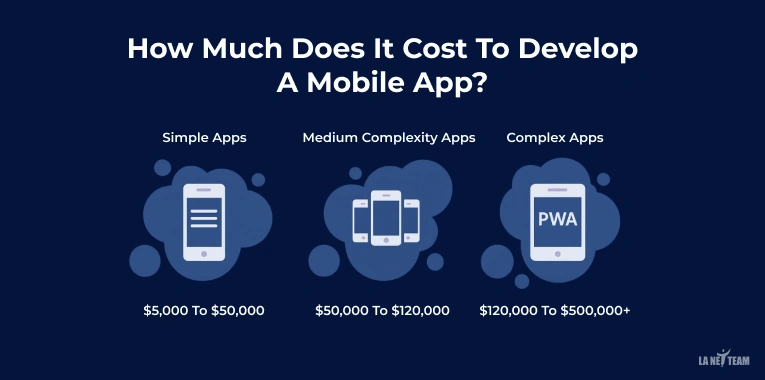
To build a mobile app, the cost can range from $5,000 to over $500,000.
It depends on many factors, such as the app that you are building, does it have more complexity, features, and the skills of the team building it.
Let’s see the breakdown based on complexity:
Simple Apps: These apps by the name ‘Simple apps’, define they are simple with straightforward functionality and minimal features. They don’t need advanced designing or integration.
Cost: $5,000 to $50,000
Example of apps: A simple calculator or a basic e-reader app.
Medium Complexity apps: These apps have more features to make the app more interactive. They require a bit of design and testing.
Cost: $50,000 to $120,000
Example of apps: Well-known apps like Instagram or Snapchat fall into this category.
Complex apps: These apps are feature-rich and can include advanced technologies. They often need to integrate with other platforms, handle sensitive data securely, and have scalable backend systems.
Cost: $120,000 to $500,000+
Examples of apps: Apps like Uber, Netflix, and Amazon are examples of complex apps.
Types Of Mobile Application Development
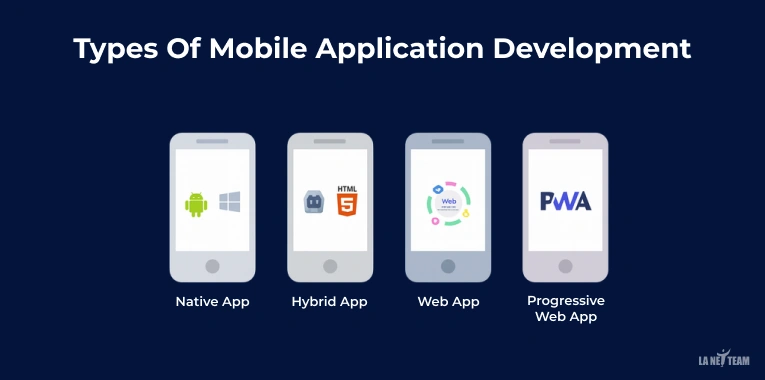
1. Native Application
They are mobile platform- specific like Apple (iOS) or Android (Google).
The applications are to be downloaded in the app stores or Google Play and installed on the gadget.
Platform-specific programming language: Developers use programming languages that are specific to a platform:
- For iOS: Swift or Objective-C
- For Android: Kotlin or Java
Example: Google Maps, Spotify, WhatsApp, Telegram
Advantage:
- Better performance
- Full access to device features
- More secure
- Easy to update
Disadvantage:
- Made for one specific platform only
- More expensive
- Harder to maintain
2. Web Apps
These aren’t real mobile apps you download from an app store. They are mobile-optimised websites that look and feel like apps. However, they run through a mobile browser.
They are built using:
- HTML
- CSS
- JavaScript
Types of Web Apps:
- Responsive Websites: Change layout depending on screen size.
- Progressive Web Apps (PWAs): Work offline, save to your home screen, and offer an app-like feel.
Pros:
- No installation needed; users access them through a browser.
- Compatible with any device that has a web browser.
- Simple to update; changes show up right away.
Cons:
- Cannot access all device features (like camera or Bluetooth).
- Slower than native apps.
- Needs internet (unless it’s a PWA with offline support).
3. Hybrid Apps
If you want an app that works on both iOS and Android without creating two separate versions, a Hybrid app is ideal.
These apps mix the benefits of native and web apps.
They use one codebase to work on different platforms. This speeds up development and cuts costs. Hybrid apps run inside a container with a WebView.
Examples: Facebook, Gmail, Instagram, LinkedIn, Twitter, Uber, Yelp
Advantage:
- Cheaper and easier to maintain
- Faster to develop with a single codebase
- Can use some features of the device
Disadvantage:
- Slower than native apps
- Less interactive for users
4. Progressive Web App
Progressive Web Apps (PWAs) are web apps that mimic native apps. They are created like typical web apps but use service workers for added features. PWAs can also be listed on the Play Store and App Store.
Examples: Pinterest, Starbucks, Adidas, Tinder, Trivago
Advantage:
- Can work offline
- Works on all platforms
- Easy & cheaper to maintain than native or hybrid apps
Disadvantage:
- Limited access to device hardware
- Cannot use some features like Bluetooth or NFC
What are the Popular frameworks for Mobile App Development?
Many frameworks help developers build mobile apps faster and more easily. Some are for just one platform, like iOS or Android. Others are cross-platform, which means they work on both.
Here are some of the most popular mobile app development frameworks:
| Frameworks | Developers | Type | Language used | Best for |
|---|---|---|---|---|
| Flutter | Cross-platform | Dart | High-performance apps with customized designs | |
| React Native | Meta (Facebook) | Cross-platform | JavaScript (or Typescript) | Need quick development and a Native like experience |
| Xamarin/.NET MAUI | Microsoft | Cross-platform | C# with .NET | Enterprise apps and apps built using Microsoft’s tech stack |
| Ionic | Ionic team | Hybrid / Cross-platform | HTML, CSS, JavaScript | Apps that need to run on multiple platforms |
| Swift (for iOS) | Apple | Native iOS development | Swift | iOS apps with high performance, smooth UI, and Apple ecosystem integration |
1. Flutter
Flutter lets you build apps for Android, iOS, the web, and desktop with one codebase. It uses a unique rendering engine, so it doesn’t need native components. This gives developers total control over how the app looks and feels.
Features:
- Hot reload: Instantly see changes in code during development.
- Beautiful, customizable widgets for UI.
- Fast performance similar to native apps.
Used by: Google Ads, Alibaba, BMW, eBay Motors
2. React Native
React Native allows one to create apps for mobile phones using JavaScript, which is among the most used programming languages. Android and iOS have the same code and hence this is extremely effective in teams that have to work on both platforms.
Features:
- Reusable components.
- Large developer community and third-party libraries.
- Native modules for device-level features (camera, location, etc.)
Used by: Instagram, Facebook, Uber Eats, Discord
3. Xamarin/ .NET MAUI
Xamarin has since become .NET MAUI (Multi-platform App UI), the future of cross-platform mobile app development at Microsoft. It enables you to create Android, iOS, macOS, and Windows applications with a C#. unified codebase.
Features:
- Access to native APIs using C#.
- Integration with Microsoft tools like Visual Studio and Azure.
- Native performance and look.
Used by: UPS, Alaska Airlines, Outback Steakhouse
4. Ionic
Ionic is a hybrid app framework that lets developers build mobile apps using standard web technologies. It is best suited to applications that do not require a heavy native performance but would be compatible with iOS, Android and the web.
Features:
- Single codebase for multiple platforms
- Large library of pre-built UI components
- Integration with popular web frameworks like Angular, React, and Vue
- Can access device features through plugins (camera, GPS, push notifications)
Used by: MarketWatch, Sworkit, McDonald’s Turkey
5. Swift (for iOS)
Swift is Apple’s official language for building native iOS apps. It’s designed to be fast, secure, and easy to read, making it perfect for apps that need smooth performance and advanced iOS features.
Features:
- Full access to iOS device features (camera, GPS, ARKit, Siri, etc.)
- Optimized for performance and battery efficiency
- Strong safety features to avoid common programming errors
- Supports modern UI development with SwiftUI
Used by: LinkedIn, Lyft, Airbnb, WhatsApp (iOS versions)
What Is the process of Mobile Application Development?
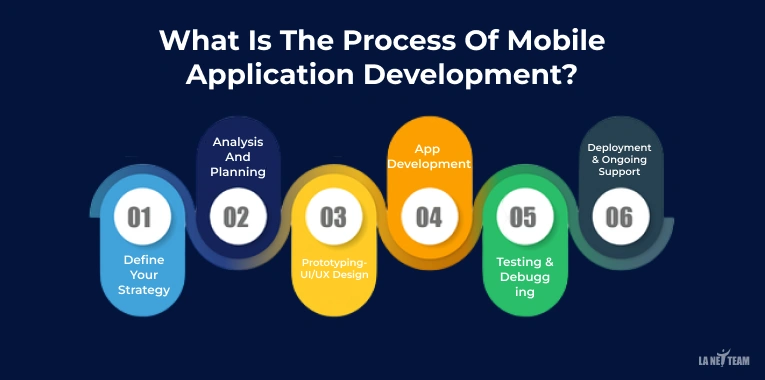
Step 1: Define your strategy
Before you build software, have a clear plan to create the best. Think about the question below before you start:
- Who will use your app?
- What’s the goal of your app?
- What will your app do?
Step 2: Analysis and planning
Once you finish your strategy, it’s time to plan the technical side for building software. This includes:
- List of features
- Choose the tech stack
- Create a timeline
- Identify resources
Step 3: Prototyping- UI/UX design
This step includes creating a blueprint for your app, known as Prototyping. It helps you see what the app will look like and how it will feel. Such as:
- Wireframes:
These are basic sketches of each screen. They show the layout and flow.
- Interactive Prototypes:
These are clickable models. They allow users to navigate the app before coding starts.
- User Feedback:
Present the prototype to potential users. This helps check if they understand the app and enjoy the experience.
Step 4: App Development
Now, you’re ready to build the app. Developers write the code using the prototype and the chosen tech stack.
Step 5: Testing & Debugging
After building the app, the next step is testing. This ensures the app works correctly. Types of testing include:
Step 6: Deployment & ongoing support
Finally, the last step is about where your app is ready to go live.
Deployment: Publish the app on the Google Play Store for Android and the Apple App Store for iOS.
Ongoing support: Your job isn’t done. You’ll need to:
- Listen to user feedback
- Fix bugs and update features regularly
- Maintain security and ensure the app keeps performing well
There is never such a thing as a finished app. Constant upgrades help make users content and entertained.
What Is the Salary of a Mobile App Developer?
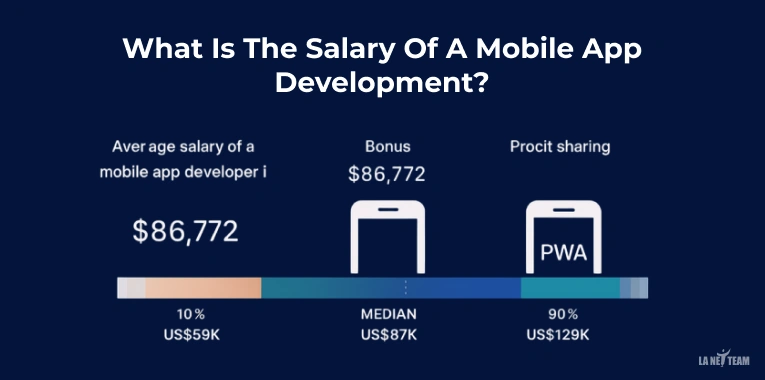
In the United States, mobile app developers typically earn from $60,000 to $130,000 per year, depending on their experience and skills.
| Developers | Experience | Salary |
|---|---|---|
| Junior Developer | 0-2 years | $60,000 – $80,000/year |
| Mid-Level Developer | 2-5 years | $80,000 – $100,000/year |
| Senior Developer | 5+ years | $100,000 – $130,000+/year |
Wrapping Up
Now, what is mobile app development? It concerns selecting the appropriate framework, the effective construction in distinct phases, and being cognizant of the fact that expenses could differ depending on the intricacy. It is a juggle between intelligent design, quick delivery, and provision of what users desire.
The best part?
Mobile app building assists you in providing the solutions that are appealing to your customers, address the actual issues, and grow along with your business.
The firms that fail to invest in sound app development are left behind to roll out obsolete functionality, as rollouts and frustrated users. The point is that the next big app is ready to be built, and will it be you or your competitors?
